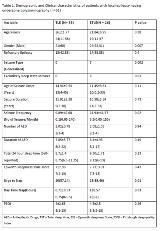REM Sleep Abnormalities Are Similarly Prevalent in Temporal Lobe and Extratemporal Lobe Epilepsy - Observations From an EEG-Polysomnography Study
Abstract number :
2.038
Submission category :
3. Neurophysiology / 3C. Other Clinical EEG
Year :
2018
Submission ID :
501533
Source :
www.aesnet.org
Presentation date :
12/2/2018 4:04:48 PM
Published date :
Nov 5, 2018, 18:00 PM
Authors :
Garima Shukla, Queen's University & KIngston General Hospital; Anupama Gupta, All India Institute of Medical Science; and Kamlesh Chakraverty, Postgraduate Institute of Medical Education and Research, Chandigarh, India
Rationale: Seizures among patients with temporal lobe epilepsy (TLE) are known to differ from those with extratemporal lobe epilepsy (ETLE) mainly through more frequent generalization and occurrence during sleep in the latter. REM sleep is known to be protective for seizure spread and hence generalization. This study aims at identifying REM sleep characteristics and their relationship with the main features that differentiate TLE versus ETLE. Methods: The clinical and polysomnography (PSG) records of consecutive epilepsy patients who underwent EEG-Polysomnography during a three year period, were included. Patients were classified as suffering from focal or generalized epilepsy; with further classification of focal epilepsy into extratemporal lobe epilepsy (ETLE) and temporal lobe epilepsy (TLE) on the basis of their clinical history, video-EEG and brain imaging data. PSG studies were reviewed for REM percentage and for presence of REM sleep without atonia (RSWA). Any PSG record was considered to show RSWA when greater than 50% of an epoch with sustained chin EMG activity (SMA) or excessive transient muscle activity (ETMA) was observed in at least one epoch. Each REM epoch was divided into ten 3-second-mini epochs and the number of mini epochs showing RSWA was calculated. Results: Among a total of 61 patients with technically acceptable PSGs, 35(57.38%) out of which, had TLE while 26(42.62) had ETLE. RSWA was found in 8(25.81) patients in the TLE group and 7(30.43) patients in the ETLE group. REM% 2 was seen in equal percentage of patients in both the TLE 7(20%)and ETLE 3(11.54%) groups (p = 0.49). However, All 7 number of patients with generalization as well as seizure frequency [0.1(0.05-240) vs 3.5(0.05-150), p = 0.02] was significantly greater in patients with ETLE. Interestingly, none of the patients with history suggestive of generalization of seizures, had RSWA. Hence RSWA was only seen among patients who never reported generalization of seizures. Occurrence of seizures exclusively during sleep was reported by none of the TLE patients and 6/26 ETLE patients, only one among which had absence of REM sleep on PSG and only one had RSWA. Conclusions: REM sleep without atonia is frequently present with patients with epilepsy, and it may have a negative association with seizure occurrence exclusively during sleep and secondary generalization in patients with focal epilepsy. Funding: No funding was received in support of this abstract.

.tmb-.jpg?Culture=en&sfvrsn=7f409e7c_0)